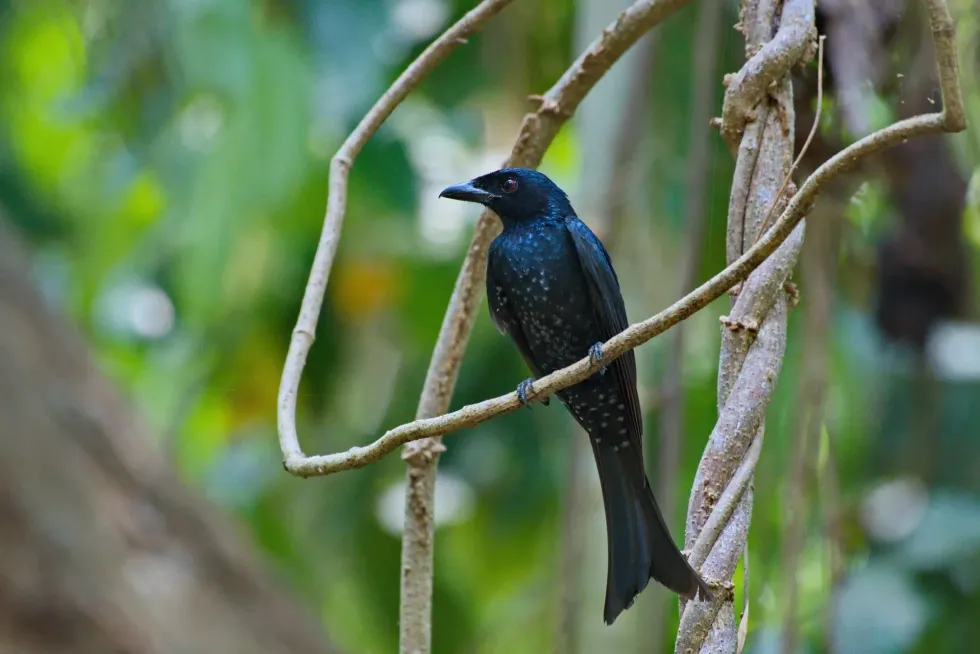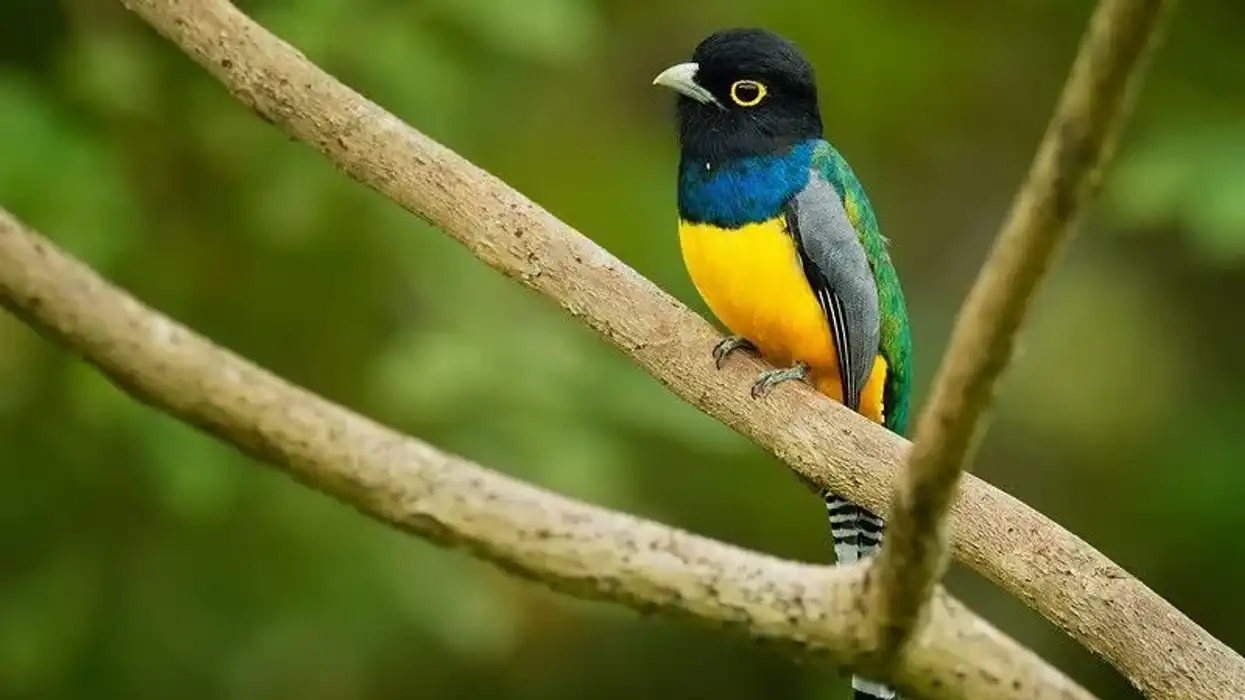Are you ready to learn all about one of the most beautiful birds of the world? The drongo has many species, but the crow-billed drongo (Dicrurus annectens) is especially found in Bhutan and India's dense evergreen and moist forests.
This bird has a forked tail and a stout black bill similar to that of a crow, but it isn't a crow.
Crow-billed drongo feathers are black, but they have a blue sheen, giving the bird a royal look. Moreover, crow-billed drongo male birds and crow-billed drongo female birds have the same appearance, meaning that it is hard to differentiate the birds.
We are yet to know a lot about the crow-billed drongo (Dicrurus annectens), especially its behavior and breeding habits. But, even without knowing a lot, it is easy to be impressed with this bird that is known for singing lovely duets during the breeding season.
Another great behavior of this bird species is that both sexes are great at parenting and taking care of their crow-billed drongo eggs.
Are you interested in learning more details about this bird species? Then, keep reading to learn more interesting crow-billed drongo facts. Also, you can read about the Amazon parrot and the palm warbler here on Kidadl for more amazing bird facts!
Crow-Billed Drongo Interesting Facts
What type of animal is a crow-billed drongo?
The crow-billed drongo (Dicrurus annectens) is one of the most popular birds of the world. It is a type of drongo bird that has a good distribution in Asian countries.
What class of animal does a crow-billed drongo belong to?
The crow-billed drongo (Dicrurus annectens) belongs to class Aves, the genus Dicrurus, and the family Dicruridae. It belongs to order Passeriformes that also includes birds like the canyon wren.
How many crow-billed drongos are there in the world?
These are one of the most widely found birds of the world, but their population data has not been studied in detail.
Where does a crow-billed drongo live?
The crow-billed drongo (Dicrurus annectens) is endemic to Asia, and the crow-billed drongo (Dicrurus annectens) can be found in countries like Bhutan, India, Malaysia, Myanmar, China, Thailand, Nepal, and Singapore. During its migration, this family of birds often visits India, Bangladesh, and the Malay Peninsula.
What is a crow-billed drongo's habitat?
The typical crow-billed drongo habitat includes dense evergreen forests, regions along the edge of the forest, or moist deciduous forest regions. At times these birds are also present at the foothills of mountains or in open areas.
When the crow-billed drongo (Dicrurus annectens) migrates, these birds look for areas with a dense forest cover and may also inhabit mangrove areas.
Who do crow-billed drongos live with?
There is not much information available related to the overall lifestyle of the crow-billed drongo (Dicrurus annectens). However, as it migrates during the winter months, we can assume that this is a bird species that has a decent amount of socialization skill.
How long does a crow-billed drongo live?
The lifespan of the crow-billed drongo (Dicrurus annectens) bird species is currently unknown due to a lack of data.
How do they reproduce?
The breeding season of this bird species belonging to the genus Dicrurus lasts from April to June, so it mainly breeds during the summer. Generally, the nest is created by both parents in just five days at the beginning of April, and it is usually built on a forked branch of a tree.
The nest is quite shallow, and it is present quite close to the ground.
The nest cup, made of leaves and grass, is designed to provide comfort for the eggs.
The female bird lays three to four pale cream speckled eggs and males spend time guarding the nest to protect it from predators during the breeding season (from April to June). The nest is very precious to these birds.
What is their conservation status?
According to data from the International Union for Conservation of Nature (IUCN) Red List, the crow-billed drongo (Dicrurus annectens) is currently classified under the conservation status of Least Concern. So, it isn't among the endangered birds of the world. However, as many forests in its habitat range are being cleared, these birds are at risk of losing their homes.
Crow-Billed Drongo Fun Facts
What do crow-billed drongos look like?
When it comes to the crow-billed drongo (Dicrurus annectens), the physical description of this bird plays a vital role in its name. It gets its name from its crow-like bill.
However, even the body of the crow-billed drongo (Dicrurus annectens) bird is covered in black feathers, just like a crow. If you don't observe the bird closely, you may mistake it for the black drongo that shares a similar habitat to crow-billed drongos.
Some people even refer to crow-billed drongos as the black drongo, but this isn't correct. The forked tail of this bird stands out the most as it hangs down while the bird is perched on a branch.
On the body of this crow-billed drongo (Dicrurus annectens) bird, you will see a variation of black feathers, as it is glossier on its backside. Some white specks might also be present on its body.
This bird has a thick and broad bill which is black, and its feet are also black. When it comes to the details, it also has beautiful blood-red irises.
Other details that make this crow-billed drongo (Dicrurus annectens) bird different from the black drongo include the blue sheen on its feathers. Also, the forked tail is smaller when it comes to the crow-billed drongo appearance.

*Please note that this is an image of a black drongo which is a close relative of the crow-billed drongo. If you have an image of a crow-billed drongo please let us know at hello@kidadl.com.
How cute are they?
The crow-billed drongo (Dicrurus annectens) is one of the most beautiful birds of the Passeriformes order, with a cute and adorable look. A description of the dark black plumage of these birds will surely captivate you.
How do they communicate?
One of the most interesting things about this crow-billed drongo (Dicrurus annectens) bird is the sound that it makes. The most common sound made by this bird is a loud musical whistle followed by 'churr' sounds. This sound has a harp-like quality. Moreover, in both Thailand and Bhutan, the crow-billed drongo (Dicrurus annectens) is often associated with beautiful duets.
How big is a crow-billed drongo?
The crow-billed drongo (Dicrurus annectens) is generally 10.6-12.6 in (27–32 cm) big. Compared to the crow-billed drongo, the little crow has an average size range of 17.7-18.9 in (45-48 cm).
How fast can a crow-billed drongo fly?
The flight speed range of the crow-billed drongo (Dicrurus annectens) bird species is currently unknown. However, its slender body and bifurcated tail help the bird to have a smooth and swift flight through the forests.
How much does a crow-billed drongo weigh?
The average weight range of crow-billed drongo (Dicrurus annectens) birds is 1.5-2.3 oz (44–68 g).
What are their male and female names of the species?
There are no separate references or names for males and females of this bird species.
What would you call a baby crow-billed drongo?
A baby crow-billed drongo sitting in its nest cup can be called a chick or a hatchling.
What do they eat?
The crow-billed drongo (Dicrurus annectens) is mainly known for eating insects. Ants and termites are integral to the diet of this species of bird and they are always on the menu.
Also, the bird often perches in shade and starts looking for insects. It can also hunt in open areas and on forest grounds. Even though most crow-billed drongos fulfill their diet by solitary hunting, sometimes flocks of the species can be seen hunting for termites together.
Are they poisonous?
No, the crow-billed drongo isn't a poisonous bird according to data.
Would they make a good pet?
Not really! As a wild bird that is found in only certain areas, it isn't a good idea to keep crow-billed drongo (Dicrurus annectens) birds as pets.
Did you know...
Louis Pierre Vieillot, a French ornithologist was the first one to define the genus Dicrurus to which the crow-billed drongo (Dicrurus annectens) belongs to.
This bird species is listed in the 'Handbook Of The Birds Of The World' by Elliott Christie. The Handbook Of The Birds Of The World' is an important book when it comes to the taxonomy of birds and is the starting place for most people looking to search for a specific bird species.
Originally, the scientific taxonomy name of the crow-billed drongo was Bhuchanga annectans. Originally, the birds first describer, Brian Houghton Hodgson, misspelled the word 'annectens' as 'annectans' while writing down the taxonomy distribution.
The word means 'connecting', and so the name was kept but the spelling was changed. Now, the name that was originally Bhuchanga annectans has been changed to Dicrurus annectens.
How did crow-billed drongos get their name?
The crow-billed drongo (Dicrurus annectens) gets its name from its stout bill which looks like that of a crow. Even the plumage of this bird is similar to that found in the family of crows.
Are crow-billed drongos endangered?
No, the crow-billed drongo isn't an endangered species of this world and there is a wide distribution of the bird in Bhutan.
Here at Kidadl, we have carefully created lots of interesting family-friendly animal facts for everyone to discover! Learn more about some other birds from our mountain chickadee facts and vesper sparrow facts pages.
You can even occupy yourself at home by coloring in one of our free printable crow billed drongo coloring pages.










